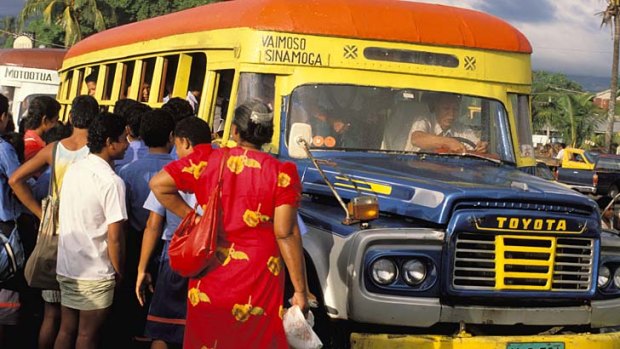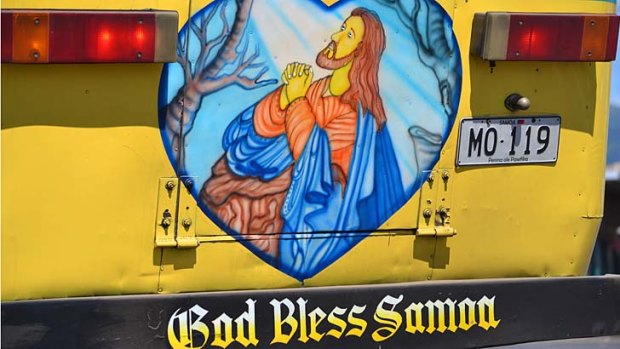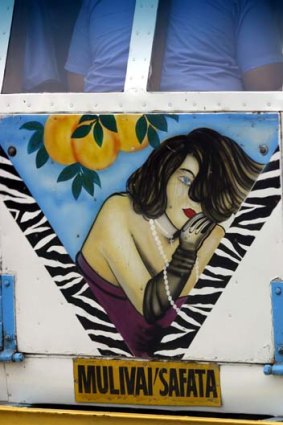
Poetry in motion ... passengers embark in Apia.Credit: Getty Images
Scott Bevan swaps rush hour for crush hour on island circumnavigations aboard boldly painted buses.
I want to ride Bon Jovi. I'm staking out a block of shade with my family in an open-air bus station by the harbour in the Samoan capital, Apia, when I notice a vehicle with the rocker's name tattooed on its side. The bus's rear has a spray-painted mural featuring skulls with crowns of flames and a woman's face rising from a moonlit sea. The last time I saw such artwork was on the side of a panel van in the 1970s, or perhaps on the cover of a rock album in the 1980s.
I love the look of the Bon Jovi bus. I want to hop on-board and get going - anywhere. But Bon Jovi is going nowhere. There's no sign of the driver.

Some Samoan buses are named after musical and religious figures.Credit: Scott Bevan
No matter. The beauty of the buses on the main island, Upolu, is that they're frequent, and most of them are handsome and poetically named. You can catch a ride on Colour Me Bad or Angel Boy Express, Broken Hearts, Broken Bones or Trust Me. Many of the buses are not just named, they're christened: Glory to God, for example; One Way Jesus; and Jesus, I Trust in You. I wonder if these names are a reflection of Samoans' religious devotion or indicate a lack of faith in the drivers' ability.
Faced with a choice of biblical proportions, we opt for something more Pacific: Laumosooi Breeze. It sounds like a cocktail, and the bus is coloured like one, with an electric-blue bonnet, red roof and yellow body. The driver tells me the name refers to the scent of a tropical flower. The bus certainly lets in the breeze; there's no glass in the passenger windows. Laumosooi Breeze seems to be built for neither speed nor comfort. But it's hardly alone there.
Many of the buses on Upolu are decades old, and their engines can be phlegmatic and flatulent. The steering wheel is often on the left, which is disconcerting at first, since Samoans drive on the left-hand side of the road. The government changed the rule a few years ago in the face of protests, including from a group called People Against Switching Sides, with fears it would create chaos on the roads. Apparently, it didn't and the old buses rolled on. Passengers need to be careful, however, when stepping off these left-hand-drive buses, as they can find themselves standing in the middle of the road.

Rear-end artworks.Credit: Getty Images
The older buses are often works of art on wheels but inside, apart from the decorative touches of each driver (Laumosooi Breeze flies a flag commemorating Samoa's recent 50th anniversary of independence), the fitout can be rudimentary.
The seats are usually wooden benches, like pews, which seem inadequate for the number of bottoms that squeeze onto them. But as a vehicle for a grassroots tour of Upolu, the bus is a wonderful experience. From the harbourside depot in Apia, buses leave for the island's east and south; another terminal close by is for buses heading west. Destinations are usually written above the windscreen. Laumosooi Breeze is cutting across the mountainous spine of Upolu to the south coast, destined for Falealili. We can't find this destination on our tourist map, which makes the journey as strangely intoxicating as the bus's colour scheme.
I ask a woman in front of us how long it takes to Falealili. "Two hours," she replies. "Maybe three."
We're off! But at a roundabout about 100 metres away we make a U-turn and return to the depot to pick up more passengers.
By the time Laumosooi Breeze leaves Apia, it's carrying not just a few dozen people but also sacks of food and building supplies. We pass the entrance to Robert Louis Stevenson's beautiful estate at Vailima, where the author of Treasure Island and Kidnapped lived, wrote and died, in 1894. Looming over the estate is Mount Vaea, where the writer is buried. We trundle past forests and a waterfall with a name almost as long as its drop, Papapapai-uta. We snatch glimpses of the sea and roll through somnolent villages, the ride punctuated by the dropping off and picking up of passengers and goods. The bus has a latch at the back where bags of concrete and planks of wood are slid from under our feet and delivered to building sites. The driver makes a food drop to an elderly woman at her fale (traditional house) in one village.
About 90 minutes after leaving Apia, Laumosooi Breeze reaches a dirt road near the village of Siuniu and does a U-turn. So we meander back to Apia, unsure whether we did actually visit Falealili. Not that we care. The return journey for two adults (our two children travel free) cost 24 tala (about $10), and we've seen so much.
This trip emboldens us to embark on the quintessential Samoan bus experience: out of Apia on a Friday afternoon, with workers returning to their villages. This is not so much rush hour as crush hour. We squeeze on-board a Sunrise bus heading west along the coast to a place called Tufulele. It's standing room only. But standing is not allowed, so three passengers fit on seats designed for two, or they sit on each other.
There's an Australian flag in the bus, a gift from a visiting weightlifting team, and faux chicken feathers strung across the windscreen. I can admire this decor up close because I'm beside the driver. I'm used to riding on buses with signs warning passengers not to talk to the driver, but on Sunrise the driver talks to me. I guess it's hard for him not to, since I'm just about sitting in his lap. He introduces himself as Moses and gives a running commentary on each village we pass. Not that I hear much over the pumping reggae music.
But the scenes of Samoa observed through the windscreen are terrific: young people practising hip-hop in a fale ("They're in a dance competition tonight," Moses says), a canoe slicing across the sea, the sober lines of a church amid the profusion of vegetation.
What makes an Upolu bus ride so memorable, however, is that it is about more than just watching Samoan life pass by. You are sitting in it, even rubbing bottoms with it.
To quote the slogan painted under a surf scene on the back of one bus, after a ride you can't help but "Luv De Island".
Air New Zealand has a fare to Apia from Sydney and Melbourne for about $800 low-season return, including tax. Fly to Auckland (about 3hr 30min), then to Apia (4hr). See airnewzealand.com.au.
Sign up for the Traveller Deals newsletter
Get exclusive travel deals delivered straight to your inbox. Sign up now.